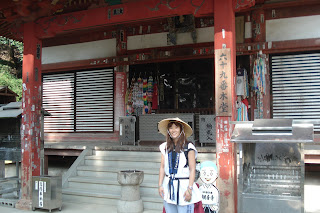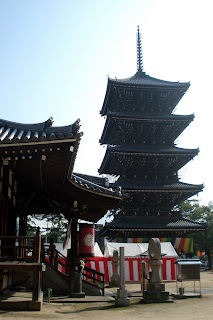




I must say the exhibit of the tea house under water was amazing. The use of water trickling down slowly into a shallow pond over a large area of a semi-circle built with heavy concrete with the ability to tell the time of day like a sundial was surreal. My only wish: that it was deep enough, and filled with hot spring water so that I could take a bath there. The exhibit also feels like a maze, because to get to the next room you have to bend over a bit to pass through a small door in the wall that reminds one of Alice in Wonderland.
When you exit through the other side, it’s a whole different world. For one it is dark with no sun, but the dim lighting allows you to see your footing as you climb a small set of stairs to a room with a wooden table, eight chairs, wooden planks from Australia that are said to be better than Japanese tatami mats because they do not soak up moisture, and smooth, grey concrete walls that were made by using symmetrical slabs of concrete and stacking them on top of each other. The only thing not symmetrical in this room is the table that looks like the biggest tree in the forest was murdered and the fattest slice was taken from its middle. The edges were not straightened like a normal wooden table. Instead the curvy, uneven shape was probably barely sanded so that your kimono wouldn’t get caught in the sharp edges when it was time to take your leave. Here we sat and I imagined we all were sitting in kimonos in a tea ceremony.
There is one tea house completely under water. Darkness overtakes the vision. The truth is only revealed on the tips of ones toes: a narrow but long slit in the wall reveals the surface level of the water and it is from here that a shy ray of light enters through. The angle is ingenious and it meets several clear rectangular prisms all neatly lined up together that reveal a small rainbow of colors. The color shines through and against the rice paper of the sliding door and this is how this tea house gets its barely adequate source of light.
Then there’s the tea house. Tatami mats cover the floor; the alcove seems modern yet ancient at the very same time. The sliding screen doors close and all eight people who decided to undertake this guided tour sit in utter silence and admiration as the dim lighting that fights for recognition seeps through slowly through the rice paper. Sitting on the tatami mat, in front of the alcove and facing the opposite direction is a barrage of black, cold waves. The current sweeps them in all directions and as they part and collide, their growling turns into high but broad bellowing wails. This is the effect created by the blocks of black rock that sit on the outer perimeter of the tatami mats that were carefully arranged.
My biggest question though: who had the time, energy, and money to build all of this luxury? Just to display it to the handful of people a day who make it out to this middle-of-nowhere, famous, yet not so famous museum.
Definitely worth going.


















































